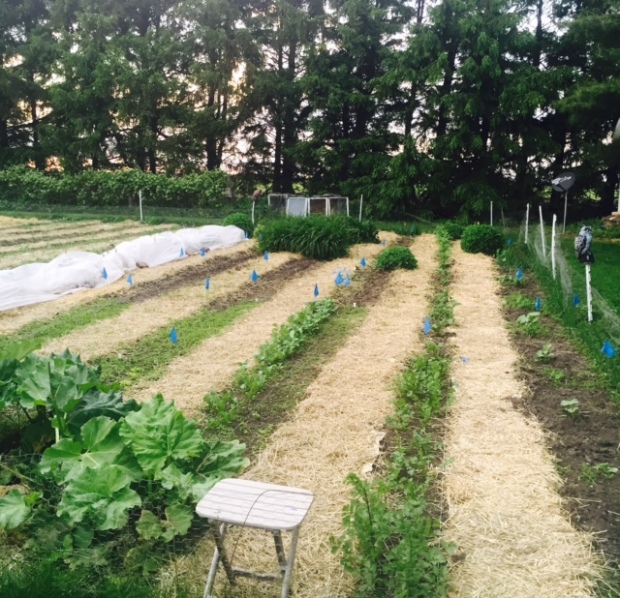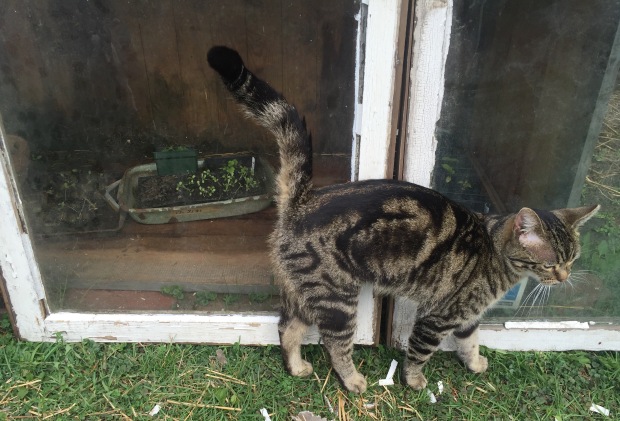“What is this tea thing?” Bri’s mom Jan had asked. She was picking beans and I was digging carrots. It was harvest day and there was a storm approaching. We only had a few hours or so before it hit.
“T thing? Ummmm I’m not sure.” I replied.
She read from the text message on her phone. “Tell Tab I’m going to do the tea thing and then plant that row of beans. Can you have her bring the hoe back over here when you guys are done?”
“Oh! That’s rabbit tea. We use it on the garden. It’s made out of rabbit poo mixed with water. It’s a fertilizer and it….”
Jan interrupts. “Ok! That’s enough! I don’t want to hear any more details. You guys are crazy. Rabbit tea….geesh,” she replied as she continued to pick beans.
I just laughed remembering when we brought the rabbit poo home. Bri was so excited she yelled, “Yay! Tea party!”
“Ha! That’s hilarious.” I replied. “We are definitely doing a blog post about a rabbit poo tea party Alice in Wonderland style.”
If you know the Alice in Wonderland story, then you know how bizarre that tea party was too. The Mad Hatter had gone crazy after being told “Off with his head!” by the Queen. Ever since then the Mad Hatter and his friend the March Hare (weird right?!) had a tea party all day long with a sleeping Dormouse where they all told crazy stories that didn’t make any sense and asked riddles that had no answers.
We’d like to explain why our tea party isn’t as crazy as the Mad Hatter’s and that it actually makes sense. Everyone knows you can use cow manure and horse manure to help fertilize crops. Well, the fact is you can actually use all sorts of animal manures in the same way and rabbit poo is one of them.
Rabbit tea is a “cool” fertilizer that won’t burn plants. Its properties are slow in releasing nitrogen making it less likely to burn the plants. Rabbit manure contains nitrogen, phosphorus, potassium and calcium with elements of essential minerals and micro nutrients. We used the “bucket fermentation” method which, according to the ATTRA Sustainable Agriculture Program “dates back hundreds of years in Europe…” (https://attra.ncat.org/attra-pub/viewhtml.php?id=125)
According to Rise and Shine Rabbitry in Maine, “Rabbit manure is one of the best manures for your organic gardens! It will increase poor soil by improving soil structure and also improving the life cycle of the beneficial microorganisms in the soil. Rabbits are very good at producing an excellent source of manure. It is rich in many nutrients and very simple to use.” (www.riseandshinerabbitry.com)
And improving soil structure is one of our main tasks at hand. As you may have noted in previous posts, we are paying close attention to our soils attempting to create the perfect ecosystem. Paying attention to the soils will help the overall Clean Acres operation since soils rich in organic matter suppresses weeds, provides higher yields, keeps pests at bay, keeps moisture in when plants need it and repels water when there’s too much. In doing so, we should create that “ecological balance” that many organic experts speak of.
Still think we are crazy for making “bunny brew”? It may sound a bit looney and maybe we do seem a bit nuts for getting so excited about sustainable agriculture. Wonder what the conversation about “bunny brew” would be like at the Mad Hatter’s tea party.
#CleanAcresLLC #garden #womenwhofarm #ProtectTheEarth #SustainableLiving #RespectTheEarth #EatForthePlanet #stopfoodwaste #organiclife #stopthechemicals #jointheorganicmovement #biologicalpestcontrol
Submitted by Tabitha Elder
Farmers Brianne Santoli and Tabitha Elder are Central Illinois residents and managers of Clean Acres Produce. Clean Acres encourages being knowledgeable about the foods that we eat, where they come from, and what was put into making them. By understanding the importance of this, we can take advantage of natural resources that allow the environment and its inhabitants to work together. The beliefs and ideas posted by Clean Acres are not intended to offend any individuals. Follow their journey of starting a Community Supported Agriculture program in the chemical free fresh food desert of rural Piatt County at http://www.cleanacresproduce.org, http://www.facebook.com/cleanacresproduce or @CleanAcres.








